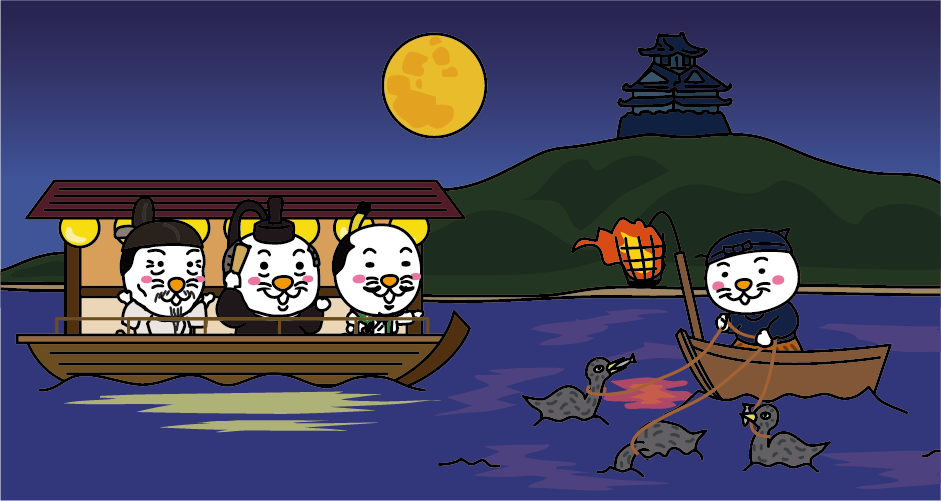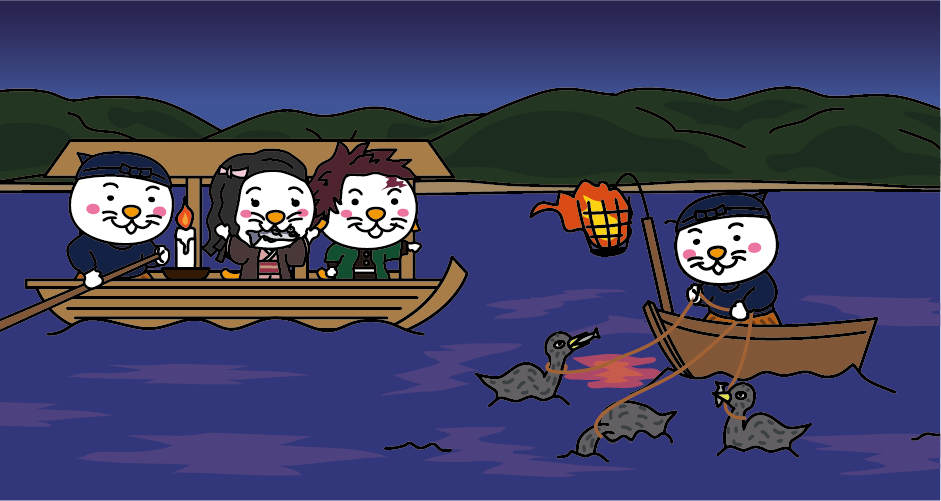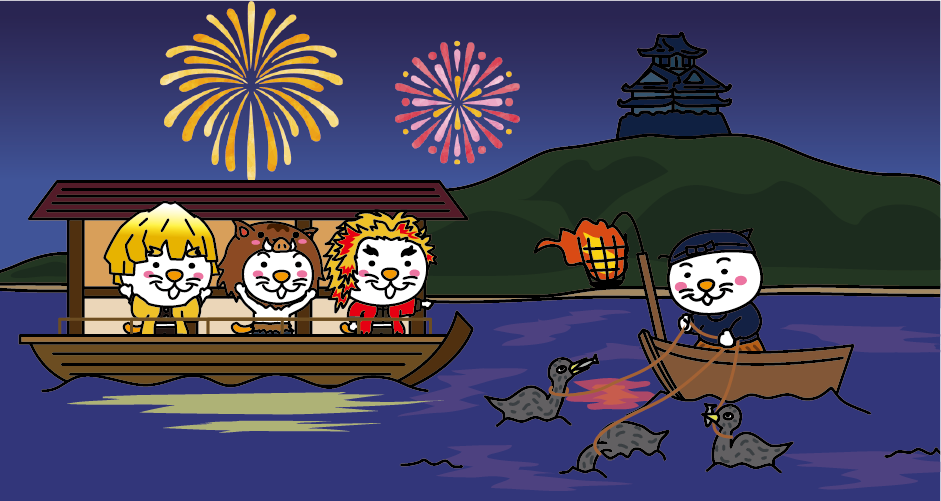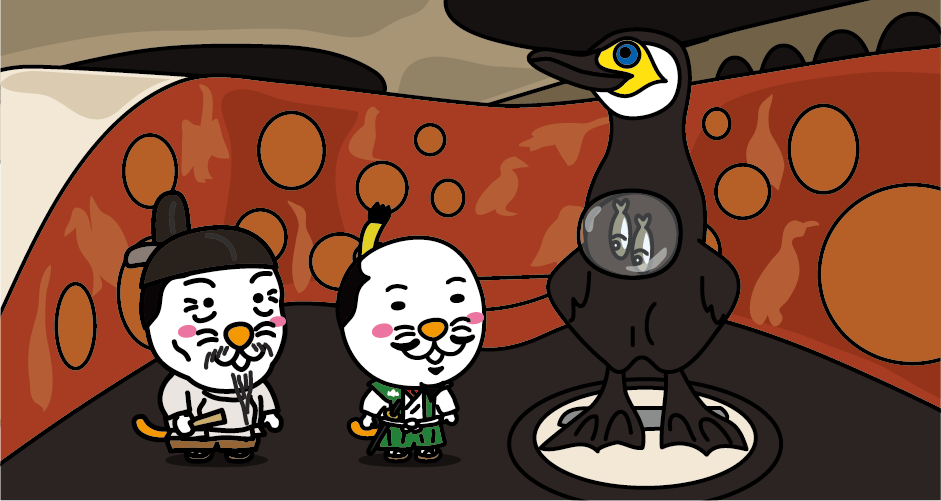Nobunaga Oda, Ieyasu Tokugawa, Basho Matsuo, and Chaplin praised cormorant fishing on the Nagara River.
From May 11th to October 15th, cormorant fishing, a traditional fishing method that has been practiced for over 1,300 years, is held on the Nagara River in Gifu Prefecture every year. Cormorant fishing on the Nagara River takes place at two locations, Cormorant fishing in Gifu City is called “Nagaragawa Ukai (Nagaragawa Cormorant Fishing)”, and cormorant fishing in Seki City is called “Oze Ukai (Oze Cormorant Fishing)”. Cormorant fishing is called Ukai in Japanese.
Nagaragawa Ukai and Oze Ukai are the only cormorant fishing in Japan that is used by the Imperial Family. The 8 times of cormorant fishing that is held every year on the land managed by the Imperial Household Agency on the Nagara River is called “Goryo Ukai (Imperial Cormorant Fishing).” The sweetfish that are caught are delivered to the Imperial Family and Ise Jingu Shrine.
<Cormorant fishing on the Nagara River>

There is a record that cormorant fishing on the Nagara River has been under the direct control of the imperial family since the Ritsuryo period (late 7th century). Since the Heian period (8th century), cormorant fishing has been seen by the emperor, members of the imperial family, court nobles, and samurai families, during the Edo period (17th century), cormorant fishing was continued under the protection of the Owari Tokugawa family. In 1890, at the request of the governor of Gifu Prefecture at the time, the former Imperial Household Ministry was decided that cormorant fishermen (called Usho in Japanese) would be given the status of staff, and cormorant fishing would be continued as “Goryo Ukai” by setting up management land on the Nagara River to protect cormorant fishing on the Nagara River.
Currently, cormorants for Nagaragawa Ukai (Nagaragawa Cormorant Fishing) and Oze Ukai (Oze Cormorant Fishing) are state employees called “Cormorant Fishing Master of the Imperial Household Agency Board of Ceremonies,” and there are six in Gifu City and three in Seki City, all of whom are hereditary. The set of 122 pieces of cormorant fishing equipment for the Nagara River is designated as an important tangible folk cultural property of Japan, and the cormorant fishing method of the Nagara River is designated as an important intangible folk cultural property designated by Gifu Prefecture.
<Cormorant fishing praised by Charlie Chaplin>

From May 11th to October 15th every year, you can watch cormorant fishing on a houseboat at Nagaragawa Ukai and Oze Ukai. You can enjoy watching the cormorant fisherman handle the ropes and the cormorants catching sweetfish up close. In the Edo period, Matsuo Basho, who visited the Nagara River, wrote a haiku: “Omoshiroute yagatekanashiki ubune kana (It is very interesting to watch the cormorants catch sweetfish one after another, but when the cormorant fishing boats are gone and the fun time is over, I feel lonely.)” In addition, Charlie Chaplin, who is famous as the comedy king of the world, has visited Japan four times, two of which he has watched cormorant fishing on the Nagara River. It seems that he enjoyed the tempura that he ate on the houseboat, and since then Chaplin has come to love tempura.
<Oze Ukai, Cormorant Fishing>

At “Oze Ukai (Oze Cormorant Fishing)” (Seki City), you can see cormorant fishing as traditional river fish fishing method, in which cormorant fishing boat on which cormorant fishermen ride and houseboat on which tourists ride run side by side down the Nagara River. Cormorant fishing boat is called “Ubune” in Japan. There is no lighting in the surrounding mountains, and the only lights are bonfires and candles. Both cormorant fishing boat and houseboat are row boats that do not have power, so the sounds of the oars and oars create a magical atmosphere in the silence.
<Nagaragawa Ukai, Cormorant Fishing>

“Nagaragawa Ukai (Nagaragawa Cormorant Fishing)” (Gifu City) is held near the upstream of Nagara Bridge. Fireworks are set off to signal the start of cormorant fishing. You can see cormorant fishing with cormorant fishing boats and going in front of you while the houseboat is anchored on the river bank, or cormorant fishing where cormorant fishing boats and houseboat run side by side down the river, or cormorant fishing where six cormorant fishing boats line up to catch sweetfish. You can view it from the Nagara River Promenade near Nagara Bridge without boarding the houseboat, but if you want to see the powerful cormorant fishing up close, the houseboat is recommended.
<Nagaragawa Ukai Museum>

Opposite bank of Gifu Castle (Gifu City) towering over Mt. Kinka, the Nagaragawa Ukai Museum (Nagara River Cormorant Fishing Tradition Museum) is located on the banks of the Nagara River. You can enjoy cormorant fishing even more if you deepen your knowledge about cormorant fishing at the Nagaragawa Ukai Museum before watching cormorant fishing. The large cormorant object in the hall is impressive.

On the right bank of the Nagara River, near the Nagaragawa Ukai Museum, there is an area where cormorant fishermen live called “Ukai no Sato (Cormorant Village)”. The cormorant fishermen take care of the cormorants at the “Ukai no Sato”. In the gardens of the cormorant fishermen’s houses, the firewood used for the bonfire is piled up, and you can see the tools used for cormorants and cormorant fishing.
Access to Nagaragawa Ukai
From Tokyo
It takes about 1 hour and 30 minutes from JR Tokyo Station to JR Nagoya Station by Tokaido Shinkansen.
From Osaka
It takes about 50 minutes from JR Shin-Osaka Station to JR Nagoya Station by Tokaido Shinkansen.
At JR Nagoya Station, transfer to the Tokaido Main Line (special rapid train) to JR Gifu Station for 30 minutes. Get off at JR Gifu Station, and from Gifu Station Bus Terminal (JR Gifu Station Kitaguchi Bus Stop) take local bus and it takes approximately 20 minutes to Nagarabashi Bus Stop. Get off at Nagarabashi bus stop, a short walk.
Access to Oze Ukai
From Tokyo
It takes about 1 hour and 30 minutes from JR Tokyo Station to JR Nagoya Station by Tokaido Shinkansen.
From Osaka
It takes about 50 minutes from JR Shin-Osaka Station to JR Nagoya Station by Tokaido Shinkansen.
At JR Nagoya Station, transfer to the Tokaido Main Line (special rapid train) to JR Gifu Station for approximately 30 minutes. Get off at JR Gifu Station and from Gifu Station Bus Terminal (JR Gifu Ekimae Kitaguchi Bus Stop) it takes approximately 50 minutes by local bus to Seki City Terminal. Get off at (transfer to) Seki City Terminal, and from Seki City Terminal to Oze Yusen-mae bus stop (Sekiitatori line) it takes about 10 minutes, Get off at Oze Yusen-mae bus stop.
